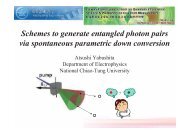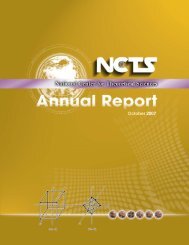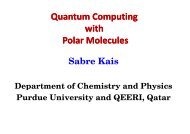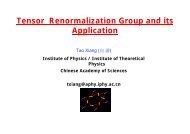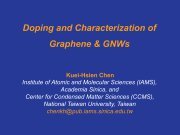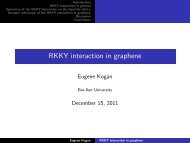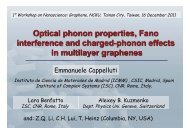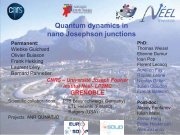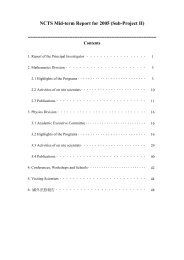Non-Classical State Generation and Quantum Memories for Light(III)
Non-Classical State Generation and Quantum Memories for Light(III)
Non-Classical State Generation and Quantum Memories for Light(III)
You also want an ePaper? Increase the reach of your titles
YUMPU automatically turns print PDFs into web optimized ePapers that Google loves.
Lecture 3• Introduction to quantummemories <strong>for</strong> light <strong>and</strong> scalable QIT• How ? Single-atom <strong>and</strong> ensemblebasedquantum memoriesEnsemble-based techniques• Duan-Lukin-Cirac-Zoller approach• Dynamic EIT memories• Photon-echo techniques
<strong>Quantum</strong> <strong>Memories</strong> <strong>for</strong> <strong>Light</strong>Photonic QubitDesideratum : Storing a quantum statewithout measuring it <strong>and</strong> reading on dem<strong>and</strong>,i.e. a coherent <strong>and</strong> reversible transferbetween atoms <strong>and</strong> light.writereadQ.Memory
<strong>Quantum</strong> <strong>Memories</strong> <strong>for</strong> <strong>Light</strong>Photonic QubitDesideratum : Storing a quantum statewithout measuring it <strong>and</strong> reading on dem<strong>and</strong>,i.e. a coherent <strong>and</strong> reversible transferbetween atoms <strong>and</strong> light.writereadQ.MemorySome important propertieswriteQ. Memory read• Storage time• Efficiency• Fidelity (conditional or not)p write• B<strong>and</strong>width, wavelength, mutimode storage…p read
One example : <strong>Quantum</strong> Repeaters1) Divide into segments <strong>and</strong>generate entanglementL 0L 0 L 0. .. .. .L. .. .. .. .. .F
Towards a Single Atom MemoryOne atom in a high finessecavity (strong coupling)First demonstration of areversible mapping
A Single Atom <strong>Quantum</strong> MemoryOne atom in a high finessecavity (strong coupling)Storage <strong>and</strong> read-out of aweak coherent pulse witharbitrary polarization stateNature, may 2011~9%
Lecture 3• Introduction to quantummemories <strong>for</strong> light <strong>and</strong> scalable QIT• How ? Single-atom <strong>and</strong> ensemblebasedquantum memoriesEnsemble-based techniques• Duan-Lukin-Cirac-Zoller approach• Dynamic EIT memories• Photon-echo techniques
The DLCZ Paradigm (2001)
Creating a Single Collective Excitation<strong>Non</strong>classical correlations between field 1 <strong>and</strong> the ensembleWriteField 1: the excitation probabilityWriteField 1Collective atomic state
Retrieving the Single ExcitationField 2ReadField 2WriteField 1ReadCollective enhancement if :Atoms at rest :Moving atoms:
Retrieving the Single ExcitationField 2ReadField 2WriteField 1ReadCollective enhancement if :Atoms at rest :Moving atoms:A good source of heralded single-photons!• Retrieval in a single mode fiber ~ 50 %• Suppression of two-photon component : 1%J. Laurat et al., Opt. Express 14, 6912(2006)
Entanglement between Two EnsemblesHeralded entanglementbetween remote memories,induced by a measurement.First experimentaldemonstration in 2005Nature 438, 828 (2005)Goal - generate the entangled state:One collective excitation “delocalized”between the two ensemblesSuccessful demonstration <strong>for</strong> memoriesseparated by 3 metersScheme from the DLCZ paper
Entanglement between Two EnsemblesAtomsentangled<strong>Light</strong>50/50Beam splitter<strong>Light</strong>Atomsentangled
Entanglement between Two Ensembles1 photon detected 1 atom transferred50/50Beam splitter
Entanglement between Two Ensembles1 photon detected 1 atom transferredLhereEntangledGeneral (<strong>and</strong> ideal) casethereRwhere =here+there
• 2 memoriesseparated by 3m• 1 collective excitationshared in an entangled statebetween the two ensemblesC.W. Chou et al., Measurement-induced entanglement <strong>for</strong> excitation stored in remote atomic ensembles, Nature 438, 828 (2005)
Entanglement between Two EnsemblesHeralded entanglementwith ‘large’ concurrence<strong>and</strong> study of the temporaldynamics1 success over 1000 tries(160 Hz preparation rate)Concurrence (0
A <strong>Quantum</strong> Repeater SegmentA rudimentary repeater segmentAll the ingredients : parallel pairs,asynchronous preparation, Bellviolation…Science 316, 1319 (2007)
• 2 nodes separated by 3m• 2 ensembles per node• Asynchronous preparation(memory) of 2 parallelnumber-state entangled pairs• Polarization coding <strong>and</strong>passive phase stabilityPolarization entanglementdistribution, violating BellC.W. Chou, J. Laurat, H. Deng, K.S. Choi, H. de Riematten, D. Felinto, H.J. Kimble, Functional<strong>Quantum</strong> Nodes <strong>for</strong> Entanglement Distribution over Scalable <strong>Quantum</strong> Networks, Science 316, 1316 (2007)
DLCZ-based Exeriments : ProgressNature Phys. 3, 765 (2007)Ensemble inside a cavity : readout>80%Nature 454, 1098 (2008)Another example of elementary repeater segment
DLCZ-based Exeriments : ProgressMemory time in the ms range…In the 0.1s range…Single-photon storage
Lecture 3• Introduction to quantummemories <strong>for</strong> light <strong>and</strong> scalable QIT• How ? Single-atom <strong>and</strong> ensemblebasedquantum memoriesEnsemble-based techniques• Duan-Lukin-Cirac-Zoller approach• Dynamic EIT memories• Photon-echo techniques
Electromagnetically-Induced Transparencysignal (0)cStrongabsorption atresonance<strong>Quantum</strong> interference effects in theamplitudes of optical transitions in atomicmedium can lead to strong modifications ofits optical properties.c0From Nature 438, 833 (2005)
Electromagnetically-Induced Transparency<strong>Quantum</strong> interference effects in theamplitudes of optical transitions in atomicmedium can lead to strong modifications ofits optical properties.signal (0)ccLeads to ‘Slow light’(Reduction of thegroup velocity)0Kramers-Kronig relations : anomaly inabsorption spectrum is accompaniedby anomaly in the dispersionFrom Nature 438, 833 (2005)
Dynamic EIT based MemoryWhen the pulse has been spatiallycompressed into the medium, thecontrol field is adiabaticallyswitched off.The quantum state of light is inthis way transferred to the atomiccoherence between the twoground states.Later, on dem<strong>and</strong>, by switching onagain the control field, thecoherence is mapped back topropagating light field.
EIT Storage <strong>and</strong> Retrieval of Single-PhotonsNature 438, 837 (2005)Nature 438, 833 (2005)
Mapping Entanglement Into <strong>and</strong> OutIdea
Mapping of Single Photon EntanglementNature 452, 67 (2008)C out /C in : 20% entanglement transfertLet’s see more in details this experiment in the next slides…
Mapping Entanglement Into <strong>and</strong> OutAtomic Ensemblesas heralded singlephoton source <strong>for</strong> proofinprinciple demonstration
• An heralded single photonsource ( =0.09 ± 0.03)• One entangler (well, a BS)10 + 012• Mapping by dynamical EIT• 20% Entanglement transfertDecouple entanglement<strong>and</strong> preparation rateK. S. Choi, H. Deng, J. Laurat <strong>and</strong> H. J. Kimble., Mapping photonic entanglement into<strong>and</strong> out of a quantum memory, Nature 452, 67 (March 2008)
The Real Story
EIT Storage in the CV Regime
Lecture 3• Introduction to quantummemories <strong>for</strong> light <strong>and</strong> scalable QIT• How ? Single-atom <strong>and</strong> ensemblebasedquantum memoriesEnsemble-based techniques• Duan-Lukin-Cirac-Zoller approach• Dynamic EIT memories• Photon-echo techniques
Rare-earth ions doped intoinorganic crystals.Ex.: Thulium, PraseodymiumSolid <strong>State</strong> Atomic Ensembles
Rare-earth ions doped intoinorganic crystals.Ex.: Thulium, PraseodymiumSolid <strong>State</strong> Atomic EnsemblesWhy they look interesting?- Large number of atoms. Notrapping needed- <strong>Non</strong>-moving atoms : echocan be efficientlyimplemented- Excellent coherenceproperties at cryogenictemperature (T
General Idea : Photon-Echo TechniquesInhomogeneous dephasingCollective state :Very fast decay of the alignement of the atomic dipolesNeeds a controlled rephasing process
General Idea : Photon-Echo TechniquesInhomogeneous dephasingCollective state :Very fast decay of the alignement of the atomic dipolesNeeds a controlled rephasing process2-pulse photon echo In the Bloch sphere :Illustrations from W. Tittel et al., Laser Photonics Review 4, 244 (2009)Rephasing at a certain time of all the dipoles triggersthe re-emission of the absorbed signal
General Idea : Photon-Echo TechniquesInhomogeneous dephasingCollective state :2-pulse photon echo In the Bloch sphereNot a:good QM strategy…- Strong optical pulse in thequantum channelIllustrations from W. Tittel et al., Laser Photonics Review 4, 244 (2009)Very fast decay of the alignement of the atomic dipolesNeeds a controlled rephasing process- Contamination of the singlephotonecho by unavoidablefluorescenceRephasing at a certain How time to of avoid all these dipoles triggersthe re-emission contaminations of the absorbed ? signal2 ways : CRIB <strong>and</strong> AFC
Controlled Reversible Inhomogenous BroadeningCRIBIllustrations from W. Tittel et al.,Laser Photonics Review 4, 244 (2009)
Controlled Reversible Inhomogenous BroadeningNature 465, 1052 (2010)=69%
Atomic Frequency Comb (AFC)• Collective state at t=0• After a time t (dephasing)• Rephasing after a time
Atomic Frequency Comb (AFC)For long-livedstorage• Collective state at t=0• After a time t (dephasing)• Rephasing after a time
Atomic Frequency Comb (AFC)For long-livedstorageSome advantages relative to CRIB:- Better use of the optical depth (OD)- Multimode capacity (only limited by the broadeningwhile in CRIB number of modes scales with OD <strong>and</strong> in EIT it scales withFor instance : 1060 modes : M. Bonarota et al., Highly multimode storage in a crystal, NJP 13, 013013 (2010)OD)
Atomic Frequency Comb (AFC)Bell violation S=2.65>2See other works in Orsay (Chanelière/Le Gouet), Lund (Kroll),…
Summary• Optical quanutm <strong>Memories</strong> <strong>for</strong>scalable QIT. .• Single-atom vs ensemble-basedCollective enhancement• DLCZ approach• EIT-based memories• Photon-echo techniques
Some Reviews<strong>Quantum</strong> interface between light <strong>and</strong>atomic ensemblesK. Hammerer et al., Rev. Mod. Phys. 82,1041 (2010)Optical quantum memoriesA.I. Lvovsky et al., Nature Photon. 3, 706(2009)<strong>Quantum</strong> repeaters based on atomicensembles <strong>and</strong> linear opticsN. Sangouard et al., Rev. Mod. Phys. 83,33 (2011)Photon-echo quantum memory insolid state systemsW. Tittel et al., Laser Photonics Review 4,244 (2009)
Some Reviews<strong>Quantum</strong> interface between light <strong>and</strong>atomic ensemblesK. Hammerer et al., Rev. Mod. Phys. 82,1041 (2010)Optical quantum memoriesA.I. Lvovsky et al., Nature Photon. 3, 706(2009)<strong>Quantum</strong> repeaters based on atomicensembles <strong>and</strong> linear opticsN. Sangouard et al., Rev. Mod. Phys. 83,33 (2011)Open Postdoc positions inexperimental quantumoptics <strong>and</strong> quantumin<strong>for</strong>mation-Q. Memory- Q. <strong>State</strong> EngineeringFeel free to contact me!Photon-echo quantum memory insolid state systemsW. Tittel et al., Laser Photonics Review 4,244 (2009)





